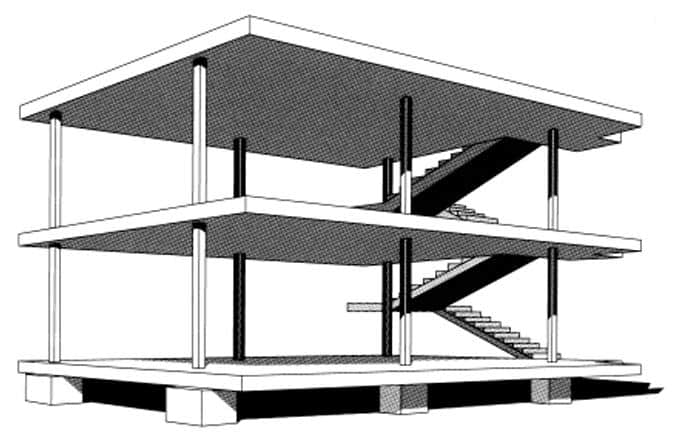BLOG
INTERESTING STUFF
THAT CAUGHT OUR EYE
Inspiring Architects: Le Corbusier

In my last Inspiring Architects feature, I looked at Frank Lloyd Wright, who – in the then unproven field of American architecture – established new styles and forms inspired by the landscape and its people to lay the foundations for a new architectural tradition. This time, I want to talk about Le Corbusier, who had the same impact in Europe.
Le Corbusier was a pioneer of modernism. Born in Switerland in 1887, he worked in the backdrop of a world that was rapidly, violently and irreversibly changing around him. As in painting and writing (which he also pursued), old models could no longer adequately serve the sheer scale of human suffering that had become so painfully apparent.
There’s an impossible amount of literature surrounding Le Corbusier but the quickest way to get a basic understanding for his approach is to look at his ‘Dom-ino’ house design, pictured above. This simple, bare, open plan formed the skeleton many of his designs going forward, an elegant and efficient canvas inspired by basic architectural forms observed as far back as the Parthenon.
It seems so familiar now, an essential piece of the vernacular of modern architecture. But put yourself in 1914 when it was first sketched and you realise it’s a radical statement that boldly departs from the Edwardian and Victorian houses that still line our roads.
But Le Corbusier did not stop at individual houses. He explored fully the basic concept of the home, and challenged established ideas for how they would be built, how they looked and how they worked – individually and collectively.
He had particular interest in those worst off in society, who were struggling under the weight of industrialism’s rapid growth. He argued that tangibly improving their standard of living with better homes wasn’t just a government’s responsibility, it was the only way of preventing bitter discontent sparking a revolution. It’s a conversation no less relevant today.
A home is the heart of happy life but providing them in a metropolis posed new problems that old models had no answers for. Le Corbusier’s concept of urbanism envisioned industrial scale while maintaining a base level of comfort, sculpted around cities designed for the modern person and all of their needs.
Some of his visions – such as airlines landing on the roofs of skyscrapers – feel quaint in their retro-futurism, but they’re still examples of the incredible, unshackled force of his imagination. By pushing the limits conceptually, his real life endeavours leapt ahead of his contemporaries and fundamentally changed how modern urban planning approached housing both at micro and macro levels.
It’s hard not to feel nostalgic for uncompromising, singular figures like Le Corbusier, who – upon seeing the problems affecting his society and its people – used his exceptional skill and intellect to provide a solution others were simply incapable of conjuring.
While the technology sector is generously stocked with ambitious ingenuity, the age of architectural grand visions feels like a distant memory. I imagine if he were resurrected in London, any plan of action he may have to solve our own housing crisis would be rendered impotent by bureaucracy.
That’s why I’m glad to be a domestic architect. My work may not touch millions like Le Corbusier’s did, but I do get to change individual lives, fundamentally improving how families interact, grow and the legacy they leave. No matter the scale of one’s work, it should have a positive impact on the world.
In Le Corbusier’s creations I sense a deep empathy for his subjects that I try to emulate in my own designs – an architect must understand life in order to build around it. Let’s hope at some point that spirit is rekindled in the policy makers of this country, or we’ll lose our best minds to lands where ambition and innovation are respected and nurtured.
By John Dyer-Grimes
